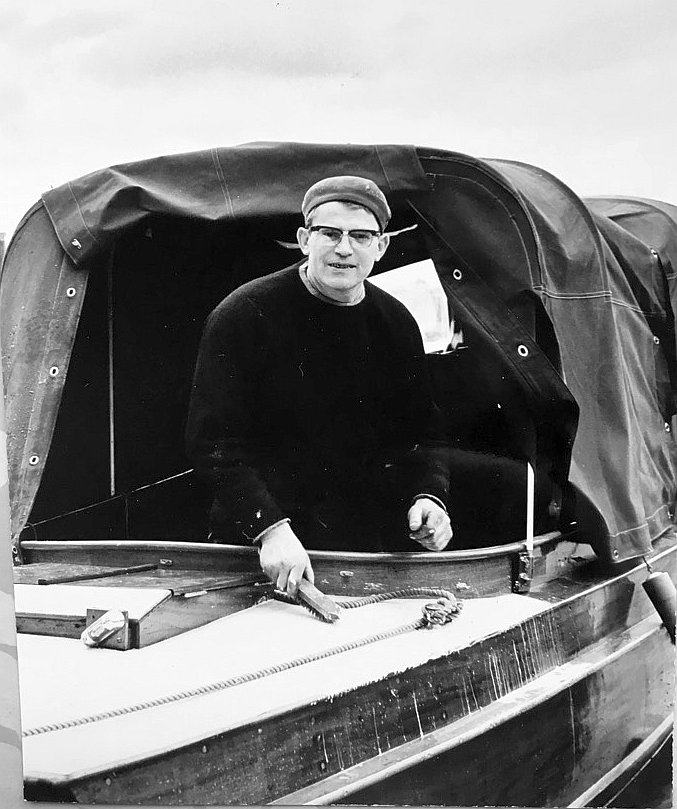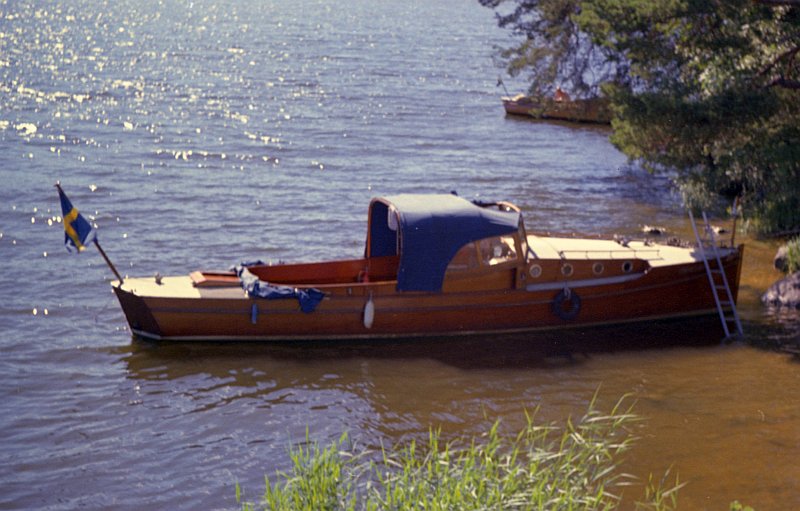|
Advertisement / Annons: |
My father's mahogany cruiser Monalisa
|
2:I. My father's cruiser Monalisa, restauration:Naviculam lignea (latin), wooden boat
Here my father proudly maneuver the boat Monalisa, it's autumn and it is time to pull her up for winter storage. We could have strong and chilly winters here in Sweden which isn't so good for wooden boats. The photo is taken at Fittja, Western side of Stockholm, you see the Goodyear factory in the background. The photo was taken 1964, the year my father bought Monalisa. The summer 1964 when I first visit Monalisa it was placed at Biskopsudden's marina in Stockholm (Sweden). What I believe is Monalisa designed by Viktor Israelsson. According to a drawing I have found was Törnqvist, J. K. one of them who ordered a Viktor Israelsson designed boat. Actually he ordered two of his boats at least, the other boat was smaller. Maybe J. K. stands for Johan Kasper, he died 1939. Monalisa had sister boats so maybe Törnqvist wasn't an owner to Monalisa but to Ingalena or Ellinor. And it could be that there were more boats built with this design. 
Now when the boat had come ashore an inspection can be done. As you see here there are four small round windows, usually there are only three or less on this type of boats. The earlier owner hasn't take care of the cruiser and now an extensive renovation work began. My father had rent a place on our neighbor's garden to have the boat at during the renovation. |
Restoration:Rudder and the whole fixture was replaced with new stainless steel self made parts, the part should surely be intact even today if the boat still exists.  Photographer Hans Falk
Photographer Hans Falk
From my friend Hans I got this photo, he helped my father with Monalisa, most about the electric problems. Both the hull and upper deck was built in mahogany. I have read that there are two kinds of mahogany, African Mahogany and South American Mahogany. I'm not sure which of these Monalisa was built of. All wood inside the cabin had blisters and has to be scratched and sanded down completely. An extensive rot in the hull and superstructure required time-consuming woodwork. At the bottom of the hull, we found lots of lead weights that constituted ballast. Even a large piece of the keel was made of lead as an extra weight.  Photographer Herbert Carlsson
Photographer Herbert Carlsson
On this photo is clearly seen the four windows which is a bit unique. C.G. Pettersson designed boats didn't have them on smaller boats. In connection with the renovation my father reconstructed it to be more practical. Among other things, the partition wall was cast away with its glass door, new larger windscreens were built by handcraft. Perhaps not what collectors want today, they want classic cruisers in their original shape. 
In early restoration days, the steering wheel is the original. Here is also the kitchen still original, later replaced with a bigger one. The kitchen also act as a seating for helmsman. On top of the instrument panel is a can with start gas, must always be used when starting the diesel engine. 
My cousin at the rudder. The bow who my father designed and built was complicated. The first two the wood cracked even when he steamed them before he bent it. 
When the boat was bought it had a grey canvas top, totally lost and Evert ordered a new in blue. It was divided in two parts and we often let the front part be up like this. |
Engines:The engine was completely worn out, probably a 4-cylinders Penta with 12 hp according to Christoffer's investigations. But I have a weak memory of that my father said it was an Opel engine, maybe it had been replaced earlier. Maybe a top speed of 8 knots which is impressive with this little engine. It had a reduction gear shaft which went broken and snapped off at the first test drive. An used marine engine was purchased, a 6-cylinders inline flathead, sorry to say, even this one was so worn that it was scrapped. It was never mounted in the boat. A fire water pump engine with magneto ignition was purchased later. In mint condition, also a 6 cylinders inline and flathead, 90 hp. It was installed but it took way too much gasoline and went bad on kerosene, assembled out after one or two years. I wish I had some photos of the fantastic installation of this engine, my father built most of the parts and the engine was really big. He had to place it above the transaxle to the propeller and a complicated belt drive had to be constructed. I believe the top speed was 12 knots with this engine, not much improvement and still seven times as much horsepower. Next engine was a Perkins diesel four cylinders inline, a lot of problems with the delivery of this engine. It was sold by a company at Södermalm and was renovated and built by a machine school. My father had to brought a couple of friends as bodyguards to get the engine delivered. A hydraulic reverse gearbox was purchased and mounted to the engine by the same school. After a hopeless summer with lots of problems things started out to work. After one more year most problems was solved and my father could start to enjoy the boat trips we made. In Sweden at the 1960s the diesel fuel cost compare to gasoline fuel was just one third. Engine's power was 40 hp and gave a top speed of 9 knots. 3 knots lower top speed relative the 6 cylinder engine but to 1/6 of the fuel cost, perfect. More information about Perkins at Perkins own homepage:
I have tried to find out more information about this Perkins engine. Now I think it was a Perkins series EA, EB, EC or ED marine engine. 40 to 45 hp and 1.6 or 1.7 liter. Weight 259 kg. I remember that it had wet sleeves and a Bosch direct injection. It also had the heat exchanger and the hydraulic gearbox option. Ligna Båtsällskap:
Early photo from 1967 with me at the steering wheel. The bow in front of me are placed where the earlier glass wall was placed, it looked fantastic, sad that it was not kept. You can also see the top of the engine box, it was made by my father and very thick to dampen the heavy sound from the diesel engine. This photograph is taken at the boat club with the name "Ligna Båtsällskap" and as you see the boats around are wooden boats, not plastic. Ligna is short for Lignum which is latin and stands for wood, earlier there have been a wooden industry here and that later gave name to the area around. I found at Ligna Båtsällskap's homepage that there are some historic documents that were interesting for me to read. |
|
I can read, among other things, that they were concerned about where they would store the boats in the winter, this was late 1960s. The current place was to be converted by the city to a park. When I read this, I remember that my father was also concerned about this. He sold Monalisa in 1973 so maybe this was one of the reasons, but I think most of it was because he no longer had time to take care of Monalisa. Boat ad:I have found an old ad from 1968 where my father try to sell his boat Monalisa, it was offered for 8000 SEK, but no one bought it. It's interesting to see that my father say that Monalisa is a Petterssonboat. I remember when I asked him what kind of boat it was he said it must be a Petterssonboat because it look like that. Now in January 2019 I have found information that it maybe is built from a Victor Israelsson drawing. A big surprise for me but very interesting. 8000 SEK (Sweden's currency Kronor) is about 800 Euro but at that time Euro wasn't invented. About 900 US Dollars. In 1968 a Swedish worker's salary might be about 200 Euro per month in Sweden. It was expensive to have an ad in a newspaper, often the ads were limited to two rows. Very different compare to when you have an ad on internet today with a lot of photos. I'm was very lucky to find this ad, I didn't know my father was trying to sell the boat already in 1968. |

|
A wider boat at Ligna:After my father had owned Monalisa a couple of years he wanted a boat that was wider and more practical. The boat next to our place in the harbor, a big white boat, was almost 3 meters wide compared to Monalisa which was only 2 meters wide. My father had gladly bought that boat, but it was sold quickly and he didn't got time to prepare giving any bid on it. I think they requested 1500 Euros for that boat in early 1970s, it had a big six cylinder Mercedes Diesel engine. 
Believe it or not, in 2018 I came by luck in contact with Ray who is a son to Åke who owned the big white boat. He had give more accurate data of the boat and a photo of Greath, the photo is taken 1967.
Ray tells: Thanks a lot Ray for this photo, it's not only the boat on the photo, you see how it's stored on land during the winter. Compare to our Monalisa this boat was much bigger. If anyone knows something about this boat, write to me: contact. Ray will find everything about the boat interesting. Last time Ray saw this boat was in the late 1970s, then the boat was loaded on a big truck and transported away. |
Ligna Båtsällskap, up and down in the water:I have many memories from when we launched the boats in the spring and later in the fall when they were taken back on land again. Almost all work was done by hand, no lifting cranes. First they take away the stands around the boat and about 20 strong men hold the boat in balance. Then about 10 heavy men lifted the boat from the boat cradle with a lever, it was a heavy log that they called "Luna". In support of it, they had a strong cradle that they called "Lunabock". With the boat being balanced by the other twenty men on this lever and Lunabock, a boat wagon was pulled out and placed under the boat by another 5 men. Still the twenty men holding the boat in balance until it was secured on the boat wagon. After the boat was safely placed on this wagon, it was pulled by hand down to the harbor 400 meters away. There was a crane that lifted the boat into the sea. Worth noting that these boats could weigh several metric tons! This was in the 1960s and if I'm lucky I might find some photography from this work. I have written to Ligna Båtsällskap and ask if they have information that can be useful in my investigation of Monalisa.
|
|